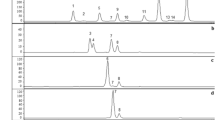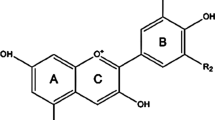Abstract
The present study evaluated the accuracy of pH differential (PD) method and HPLC method expressed as cyanidin-3-glucoside equivalent (CGE) for measuring total anthocyanin (TA) contents of five berries. Major anthocyanins of blueberry, blackberry, black currant, raspberry, and cranberry were analyzed with quantitative HPLC (q-HPLC) method using individual anthocyanin standards and used as a standard reference of comparison. PD method and HPLC method showed similar trend, although absolute amounts of TA differed in blueberry and cranberry. However, data showed that the TA of black currant and raspberry expressed as CGE considerably deviated from those obtained by q-HPLC. This discrepancy was due to underestimating TA of these two berries which contain disaccharides as major glycones, when expressed as CGE. On the other hand, when expressed as their major anthocyanin equivalents, TA of these two berries showed better approximate values with those by q-HPLC method. In addition, this finding was confirmed by Bland–Altman analysis. Our findings demonstrated that the type of glycone in berries is a critical factor to cause discrepancy between TA as CGE and actual TA and should be considered for measuring TA contents.


Similar content being viewed by others
References
J. He, M.M. Giusti, Anthocyanins: natural colorants with health-promoting properties. Annu. Rev. Food Sci. Technol. 1, 163–187 (2009)
S.G. Lee, B. Kim, Y. Yang, T.X. Pham, Y.-K. Park, J. Manatou, S.I. Koo, O.K. Chun, J.-Y. Lee, Berry anthocyanins suppress the expression and secretion of pro-inflammatory mediators in macrophages by inhibiting nuclear translocation of NF-κB independent of NRF2-mediated mechanism. J. Nutr. Biochem. 25, 404–411 (2014)
D.X. Hou, T. Yanagita, T. Uto, S. Masuzaki, M. Fujii, Anthocyanidins inhibit cyclooxygenase-2 expression in LPS-evoked macrophages: structure-activity relationship and molecular mechanisms involved. Biochem. Pharmacol. 70, 417–425 (2005)
A. Karlsen, L. Retterstol, P. Laake, I. Paur, S.K. Bohn, L. Sandvik, R. Blomhoff, Anthocyanins inhibit nuclear factor-kappaB activation in monocytes and reduce plasma concentrations of pro-inflammatory mediators in healthy adults. J. Nutr. Educ. Behav. 137, 1951–1954 (2007)
M.G. Miguel, Anthocyanins: antioxidant and/or anti-inflammatory activities. J. Appl. Pharm. Sci. 01, 07–15 (2011)
X. Wu, R.L. Prior, Systematic identification and characterization of anthocyanins by HPLC-ESI-MS/MS in common foods in the United States: fruits and berries. J. Agric. Food Chem. 53, 2589–2599 (2005)
Q. You, B. Wang, F. Chen, Z. Huang, X. Wang, P.G. Luo, Comparison of anthocyanins and phenolics in organically and conventionally grown blueberries in selected cultivars. Food Chem. 125, 201–208 (2011)
H.-J. Fan-Chiang, R.E. Wrolstad, Anthocyanin pigment composition of blackberries. Food Chem. Toxicol. 70, 198–202 (2005)
J. Lee, C. Rennaker, R.E. Wrolstad, Correlation of two anthocyanin quantification methods: HPLC and spectrophotometric methods. Food Chem. 110, 782–786 (2008)
J. Lee, R.W. Durst, R.E. Wrolstad, Determination of total monomeric anthocyanin pigment content of fruit juices, beverages, natural colorants, and wines by the pH differential method: collaborative study. J. AOAC Int. 88, 1269–1278 (2005)
M.M. Giusti, R.E. Wrolstad, Anthocyanins: characterization and measurement of anthocyanins by uv-visible spectroscopy, in Current Protocols in Food Analytical Chemistry, ed. by R.E. Wrolstad (Wiley, London, 2001), pp. F1.2.1–1.2.13
R.E. Wrolstada, R.W. Dursta, J. Lee, Tracking color and pigment changes in anthocyanin products. Trends Food Sci. Technol. 16, 423–428 (2005)
P. Rapisarda, F. Fanella, E. Maccarone, Reliability of analytical methods for determining anthocyanins in blood orange juices. J. Agric. Food Chem. 48, 2249–2252 (2000)
J. Bakker, N.W. Preston, C.F. Timberlake, The determination of anthocyanins in aging red wines: comparison of HPLC and spectral methods Am. J. Enol. Vitic. 37, 121–126 (1986)
L. Mondello, A. Cotroneo, G. Errante, G. Dugo, P. Dugo, Determination of anthocyanins in blood orange juices by HPLC analysis. J. Pharm. Biomed. Anal. 23, 191–195 (2000)
G. Niketic-Aleksic, G. Hrazdrina, Quantitaive analysis of the anthocyanin content in grape juices and wine. LWT Food Sci. Technol. 5, 163–165 (1972)
F.J. Francis, in Anthocyanins as Food Colors, ed. by P. Markakis (Academic Press, London, 1982), pp. 181–207
C.S. Ku, S.P. Mun, Optimization of the extraction of anthocyanin from Bokbunja (Rubus coreanus Miq.) marc produced during traditional wine processing and characterization of the extracts. Bioresour. Technol. 99, 8325–8330 (2008)
G.A. Camelo-Mendez, J.A. Ragazzo-Sanchez, A.R. Jimenez-Aparicio, P.E. Vanegas-Espinoza, O. Paredes-Lopez, A.A. Del Villar-Martinez, Comparative study of anthocyanin and volatile compounds content of four varieties of Mexican Roselle (Hibiscus sabdariffa L.) by multivariable analysis. Plant Food Hum. Nutr. 68, 229–234 (2013)
A. Chandra, J. Rana, Y. Li, Separation, identification, quantification, and method validation of anthocyanins in botanical supplement raw materials by HPLC and HPLC-MS. J. Agric. Food Chem. 49, 3515–3521 (2001)
J. Lee, C.E. Finn, Anthocyanins and other polyphenolics in American elderberry (Sambucus canadensis) and European elderberry (S. nigra) cultivars. J. Sci. Food Agric. 87, 2665–2675 (2007)
Acknowledgments
Freeze-dried samples of five berries, including blueberry, blackberry, black currant, raspberry, and cranberry, were kind gifts from the VDF FutureCeuticals (Momence, IL, USA). This study was supported by the Nutricia Research Foundation Nutrition Research award and the University of Connecticut USDA Hatch grants to Drs. Ock K. Chun and Sung I. Koo.
Author information
Authors and Affiliations
Corresponding author
Ethics declarations
Conflict of interest
The authors declare that they have no conflict of interest.
Rights and permissions
About this article
Cite this article
Lee, S.G., Vance, T.M., Nam, TG. et al. Evaluation of pH differential and HPLC methods expressed as cyanidin-3-glucoside equivalent for measuring the total anthocyanin contents of berries. Food Measure 10, 562–568 (2016). https://doi.org/10.1007/s11694-016-9337-9
Received:
Accepted:
Published:
Issue Date:
DOI: https://doi.org/10.1007/s11694-016-9337-9




